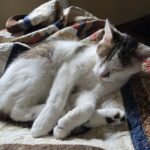It’s important for us to pause and ponder about HSPs and perception, because the way we see the world determines our experience of it.
This week, I’ve found myself thinking about how being a highly sensitive person (HSP) affects our perception, and how our perception, in turn, affects our lives.
What brought this up? My sister sent along a picture of a snake. A five-foot-long black snake, to be specific—sunning itself outside the back door of our family cottage, where you’d have to step over it on your way down to the outhouse.
Now, black snakes are harmless (assuming you aren’t a mouse, a bird, or a frog.) My own reptilian brain never got that memo, however. Upon seeing that photo, it spit out an ancient algorithm: “snake = danger.” Ever since then, I’ve been seeing snakes.
First, I saw an impossibly long black snake draped over our deck. It was not a snake, though. It was our garden hose. Then I saw a shorter, clearly dead black snake while out on a walk around the neighborhood. That one turned out to be a piece of hose from a car. I’ve passed that “snake” twice more since then, and I had to correct my perception each time.
Our evolutionary stance of vigilance
Why on earth would I see a hose or a bit of black pipe as a snake? I think it’s because we are evolutionarily wired to attend to danger. The primal part of my brain doesn’t care about context. Nor is it subject to logic or reason. I can tell it, “That’s a hose, dummy, not a snake! And even if it WERE a black snake, they are scared of humans, and harmless to them!” It doesn’t care.
I care, though. I see this weird, repeated mis-perception as a wake-up call. In effect, I put on a pair of snake-fearing contact lenses. Through these particular lenses, anything long, slender, and black is judged to be a snake—all because I looked at one picture.
I’ve read—and I believe it’s true— that humans are innately biased, and that we are not aware of our own biases. That’s worrisome. From that point of view, my series of snake sightings was a gift: a rare opportunity to watch the illogical workings of my own mind.
If I’m making mistaken assumptions about hoses and snakes, what else am I seeing and misperceiving? Even worse, how can I uncover my misperceptions, if I can’t see them?
Can’t I see my own biases, if I try hard enough?
No. Not by myself, anyway. This snake experience was a rare moment of clarity. It made me realize that bias awareness is particularly important for those of us with highly sensitive nervous systems. Why? Because when we think, we think long and deeply… and our subtly observant minds are quick to collect evidence of our resulting beliefs.
In other words, if we base our thinking process on false perceptions and assumptions, we can get in deep trouble quickly. Think about it: my evolutionary conditioning around snakes was evidently enough to create that subtle vigilance in me, despite the fact that I’ve never had a bad experience with a snake.
Now imagine you have had painful or traumatic experiences around a particular stimulus: a person, a place, a certain situation. The vigilant part of your brain now has a far more powerful motivation to put on fearful contact lenses. Your mind effectively sets what I call a trauma perimeter: that is, a field of vigilance surrounding anything and everything remotely associated with the trauma.
Two perception-related tasks for HSPs
So far, we’ve seen that we are bound to be biased—being human, as we are. We’ve also concluded that our deep-processing brains can get us in trouble. This presents us with two challenging tasks:
- To heal any trauma we are carrying, so we can lessen our susceptibility to bias
- To take responsibility for doing everything we can to make sure the basis of our thinking is accurate to start with.
I think it’s in our conscientious nature to attempt these difficult tasks. We can each only do what we can, though. Our level of success depends upon two factors: the strength of our commitment, and our resources of energy, information, and support.
Am I saying you and I can’t start living with integrity until we are “all healed?” No. That would be crazy. Besides, in my experience, doing my best to live the life I want to live is the most powerful stimulus to healing that I know of.
Still, even if I accept that healing trauma is an ongoing process, I’m left with more questions. How do I take responsibility for determining if my perceptions are accurate? How can I discern which “contact lenses” I’m wearing at this moment? What can I do to take responsibility for my own perception, when I can’t see it clearly?
Tools for awareness of our perception
Holding myself to standards of self-awareness is the essential first step on this path of self-responsibility. I can determine to remind myself often that—
- I don’t know
- I could be wrong
- I’m almost certainly making unconscious assumptions
Simply by remembering these three facts, you can make a giant leap towards assuming responsibility for your own perceptions. Personally, I’ve found the effort deeply humbling. I feel like a pig trying to knit.
I have to make the effort: even a tiny bit of progress is worth it. However, for me, though, this cognitive commitment has not been enough. I’ve needed a consistent practice to help me strengthen my self-awareness. To sustain that kind of practice, I need three things:
- A reliable way to regulate my nervous system
- A supportive spiritual routines
- A meditation practice focused on spiritual connection (not merely calmness and relaxation.)
Through these practices, we go beyond self-awareness to Self-awareness—the awareness of our essential being. This in turn provides the ground for true open-mindedness: the knowledge that all beings are “of” this essence.
Claiming our bigger role in the world
In the midst of these snake-inspired ponderings this week, I heard an Indigo Girls song for the first time, Closer to Fine. Wow. What an elegant expression of the challenge of living in our negatively biased minds:
Well, darkness has a hunger that’s insatiable
And lightness has a call that’s hard to hear.
And then the Girls offer a way out. I love it when that happens—when a songwriter expresses, in a few poetic words, something you’ve been grasping at, and you get that deep sigh of relief: “Ahhhh…yes. That’s it.:”
There’s more than one answer to these questions
Pointing me in a crooked line
And the less I seek my source for some definitive
Closer I am to fine, yeah
We can get better at hearing the call of lightness. We have to want to hear it, and to be patient, and to persistently work at it. If we make that commitment—if, beyond our chosen profession, beyond our family ties, beyond our personal ups and downs, we choose to use our formidably (and sometimes painfully) self-conscious brains to become more Self-conscious—we can contribute to peace in this bruised, burning world we live in.
We just need to stay open, moment by moment, to the humbling possibility that we could be wrong.
Image: 2023 Elizabeth Agnew. Thank you, Lib!




















Great Article! I am reading “A course In Miracles” in a group and this is EXACTLY what we are learning!! And my daughter had the same realization yesterday. She went up to a boy a camp and said “hi”. He was frozen and barley mumbled back to her. She was very sad the rest of the day! Later, he sent a message via some media platform, that he was sorry for his awkwardness. She saw the message right before he deleted it! She sent him a message back and he confirmed he LIKES her and was surprised when she approached him and was taken aback… LIFE!
Oh, what a poignant story and one I (and many of us I’m guessing) can relate to: coming off completely differently than intended because I felt so horribly self-conscious. That’s a lovely example of the power of not assuming. Thanks so much for sharing this. It really is a spiritual issue in the end.
I like the concept of a trauma perimeter.
It can apply to a physical perimeter, emotional perimeter, psychological perimeter, spiritual perimeter, social perimeter, intellectual perimeter…and so on.
I understand this concept better than a boundary.
What bothers me is that in new situations or with new people, I often don’t know what the perimeter is! And when I cross it and go into overwhelm then I get self conscious and upset at myself for not noticing the perimeter and my trauma experience increases.
I think our childhood experiences also play a role in how we set up our perimeters. And this translates to how much we will tolerate regarding trauma perimeters.
An overwhelming cycle until we finally figure out how to not cross these trauma perimeters and eventually find a way to decrease the trauma perimeter size.